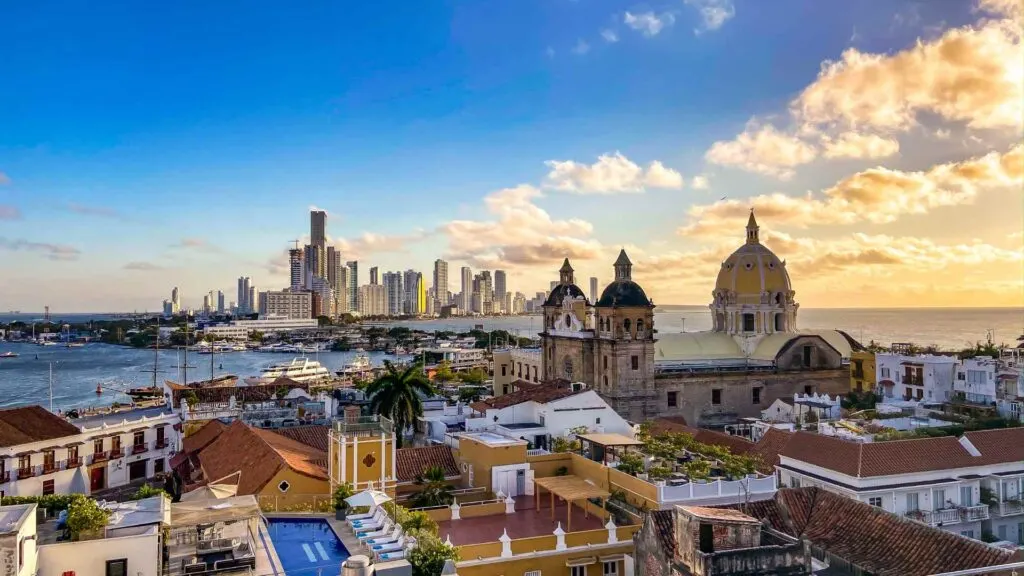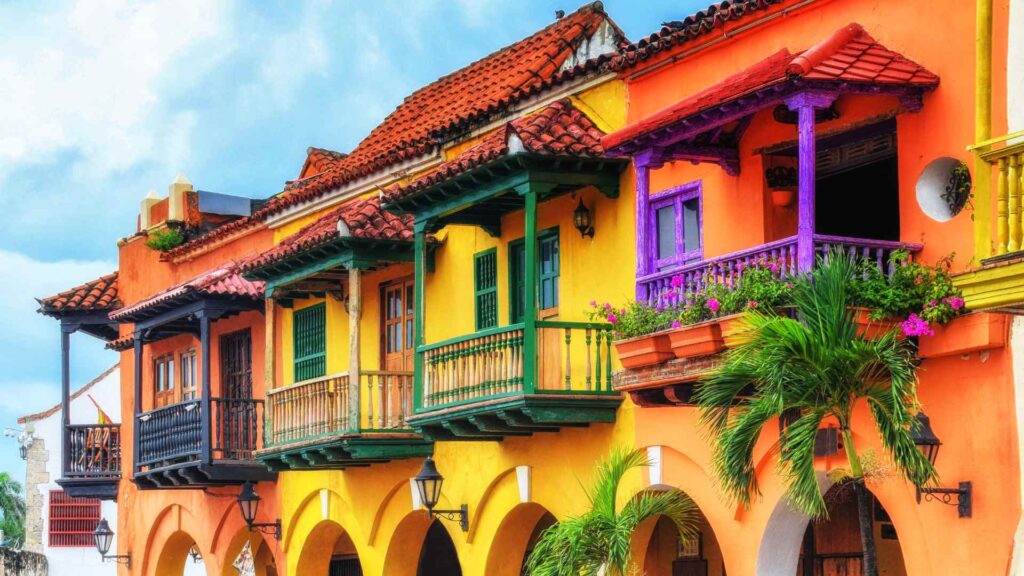Colombia is a country of vibrant culture, stunning landscapes, and rich traditions. From colorful festivals to unique biodiversity, there’s so much to discover.
Here are 145 intriguing fun facts that will deepen your appreciation for Colombia, split into different categories, making it easy to explore all the aspects of this incredible country!
History and Heritage
- Colombia was named after Christopher Columbus, though he never actually set foot there.
- The famous “Lost City” of Colombia, Ciudad Perdida, predates Machu Picchu by 650 years.
- Bogotá, the capital city, was founded by Spanish conquistadors in 1538.
- Colombia’s gold museum, the Museo del Oro in Bogotá, has over 55,000 gold artifacts.
- Simon Bolívar, known as “El Libertador,” led Colombia’s liberation from Spain.
- The country experienced a 1,000-day civil war from 1899 to 1902.
- Colombia’s indigenous population includes over 80 ethnic groups with unique languages and traditions.
- Cartagena’s Old City is a UNESCO World Heritage site known for its colonial architecture.
- Colombia was part of the union of Gran Colombia, alongside Venezuela, Ecuador, and Panama, until 1831.
- The national flag, with yellow, blue, and red, represents gold wealth, oceanic borders, and the blood of martyrs.
- El Dorado, the mythical city of gold, is said to have originated from the legends of Colombia’s Muisca people.
- Colombia’s independence day is celebrated on July 20 each year.
- The term “coffee cultural landscape” refers to regions in Colombia recognized as UNESCO sites for coffee production.
- Colombia’s congress officially recognized vallenato, a popular folk music genre, as cultural heritage in 2006.
- The pre-Columbian civilization in Colombia was highly skilled in pottery and metalworking.

Geography and Nature
- Colombia is the second most biodiverse country in the world after Brazil.
- Colombia is one of only 17 megadiverse countries, home to about 10% of the world’s species.
- The Andes mountains run through Colombia, with three distinct mountain ranges within the country.
- Colombia is the only South American country with both Caribbean and Pacific coastlines.
- The Amazon rainforest covers about one-third of Colombia’s total area.
- The Cocora Valley is home to the world’s tallest palm trees, the wax palms, which can grow up to 200 feet.
- The Tatacoa Desert, one of Colombia’s unique natural landscapes, is famous for stargazing.
- Colombia has five distinct geographic regions: Andean, Caribbean, Pacific, Amazon, and Orinoco.
- The Chicamocha Canyon in Colombia is one of the largest canyons worldwide.
- Colombia has over 60 national parks that protect diverse ecosystems.
- Los Nevados National Park has several glaciers despite Colombia being on the equator.
- Colombia is home to the Caño Cristales, also known as the “River of Five Colors.”
- The Orinoco River forms part of the border between Colombia and Venezuela.
- Colombia’s coastline along the Caribbean Sea is over 1,000 miles long.
- The country experiences no seasons; the climate varies by altitude instead.
Wildlife Wonders
- Colombia has the largest variety of orchids, with over 4,000 species.
- Over 1,900 bird species are found in Colombia, making it the most bird-diverse country.
- The pink river dolphin, found in Colombia’s Amazon, is the largest freshwater dolphin species.
- Colombia is home to spectacled bears, the only bear species native to South America.
- Jaguars inhabit Colombia’s forests and are an essential part of local ecosystems.
- The poison dart frog, one of the most toxic animals, is native to Colombia.
- Colombia has over 1,500 species of butterfly, which represent about 20% of all butterfly species.
- The Magdalena River is a crucial ecosystem, home to unique fish species.
- Colombia has six species of big cats, including the jaguar and ocelot.
- Colombia’s Andean condor, the national bird, has the largest wingspan of any land bird.
- Sloths, found in Colombia’s rainforests, are known for their slow movements and moss-covered fur.
- The Capuchin monkey, often seen in Colombia, is highly intelligent and social.
- The cotton-top tamarin, one of the world’s smallest monkeys, is found only in Colombia.
- Colombia is known for its rare and colorful poison dart frogs, each species unique to its region.
- The Sierra Nevada de Santa Marta is one of the world’s most isolated and unique ecosystems.

Cultural Riches
- Colombia is known as the “Land of a Thousand Rhythms” for its diverse music styles.
- The Carnaval de Barranquilla, one of the largest carnivals in the world, has UNESCO recognition.
- Cumbia, a music and dance style originating in Colombia, combines Indigenous, African, and Spanish influences.
- Colombia has a strong salsa culture, especially in the city of Cali, known as the “Salsa Capital.”
- The traditional Colombian hat, the sombrero vueltiao, is made from native cane plants.
- Colombian coffee culture has deep roots, with coffee farms and traditions centuries old.
- Colombia celebrates Día de las Velitas (Day of the Little Candles) every December 7.
- The famous “Bandeja Paisa” is a Colombian dish that includes rice, beans, meat, and fried plantains.
- Colombia’s national sport is tejo, a game that involves throwing metal disks at a target.
- The vallenato, a musical genre originating from the Caribbean coast, tells stories through lyrics.
- Gabriel García Márquez, Nobel Laureate, wrote “One Hundred Years of Solitude,” inspired by Colombia.
- The guacharaca, a traditional percussion instrument, is essential in vallenato music.
- Colombia celebrates “Semana Santa” (Holy Week) with grand religious processions.
- The “Palenqueras” are Afro-Colombian women from Cartagena who sell fruit while dressed in colorful attire.
- Colombia’s salsa dancing style is fast-paced and involves intricate footwork.
Famous Cities and Attractions
- Bogotá’s Gold Museum is one of the most popular tourist attractions in Colombia.
- Medellín is known as the “City of Eternal Spring” for its year-round pleasant weather.
- Cartagena is famous for its walled old town, colorful streets, and historical sites.
- Cali, known for its vibrant nightlife, is considered Colombia’s salsa capital.
- Villa de Leyva, a preserved colonial town, is known for its beautiful cobblestone streets.
- San Andrés Island is known for its beautiful beaches and coral reefs.
- Popayán is called the “White City” for its whitewashed colonial architecture.
- The coffee region, or “Eje Cafetero,” offers tours of coffee plantations and picturesque landscapes.
- Tayrona National Park is a popular coastal destination with lush forests and Caribbean beaches.
- Bogotá’s Monserrate mountain offers breathtaking city views and a famous sanctuary.
- San Agustín is known for its ancient stone statues and pre-Columbian archeological sites.
- Leticia, in the Amazon region, is a hub for exploring the Colombian rainforest.
- Barranquilla is famous for its lively carnival celebrations.
- The Salt Cathedral of Zipaquirá, an underground church, is a unique architectural marvel.
- Guatapé is famous for its colorful houses and the giant rock, El Peñol.

Festivals and Traditions
- The Carnaval de Barranquilla is one of the biggest and most colorful celebrations in Colombia.
- The Feria de las Flores in Medellín is an annual flower festival showcasing elaborate flower displays.
- Colombia celebrates “Día de los Muertos” (Day of the Dead) to honor deceased loved ones.
- The Festival Iberoamericano de Teatro in Bogotá is one of the largest theater festivals worldwide.
- Black and White Carnival in Pasto celebrates the region’s cultural diversity.
- Every year, Colombia celebrates a Coffee Cultural Festival in the town of Manizales.
- The Bogotá International Film Festival showcases Colombian and Latin American films.
- During Semana Santa, Popayán hosts one of the world’s most famous religious processions.
- San Pedro Alejandrino’s Day commemorates the death of Simon Bolívar.
- The Festival of Lights in Villa de Leyva is a dazzling December celebration with fireworks.
- Medellín’s Christmas lights display, known as “El Alumbrado,” is famous worldwide.
- The Joropo Festival in Villavicencio showcases traditional Llanero music and dance.
- Santa Marta hosts the Fiesta del Mar, celebrating coastal and maritime culture.
- The Cali Fair, held every December, is known for its music, dancing, and parades.
- In Colombia, December 7 is celebrated as Día de las Velitas, marking the start of the holiday season.
Colombian Cuisine
- Arepas, a traditional food made from corn, are enjoyed throughout Colombia with various toppings.
- Ajiaco, a hearty chicken soup, is popular in Bogotá and the surrounding highlands.
- Sancocho is a traditional soup made with meat, plantains, yuca, and corn.
- Bandeja Paisa, a filling dish, typically includes rice, beans, avocado, fried plantains, and chicharrón.
- Empanadas, fried pastries stuffed with meat or cheese, are a popular street food.
- Cholados, a fruit and syrup dessert topped with condensed milk, are refreshing treats.
- Colombian coffee is world-famous, known for its rich flavor and high quality.
- Buñuelos, deep-fried cheese balls, are especially popular around Christmas.
- The tropical fruit lulo is often used in Colombian juices for its unique, tangy flavor.
- Changua is a traditional milk and egg soup commonly eaten for breakfast in Bogotá.
- Colombian hot chocolate is often enjoyed with cheese, which is melted into the drink.
- Obleas are thin wafer cookies often sandwiched with caramel or fruit fillings.
- Lechona is a dish featuring a whole pig stuffed with rice, peas, and spices.
- Cazuela de Mariscos is a creamy seafood stew popular along the Caribbean coast.
- Freshly cut tropical fruits like guava, maracuya, and papaya are commonly enjoyed.
Bonus Facts
- Colombia is the largest producer of emeralds globally.
- Colombia has 18 public holidays, one of the highest worldwide.
- Medellín hosts an annual fashion week known as “Colombiamoda.”
- The country’s name in Spanish is “Colombia,” not “Columbia.”
- Colombia has a vibrant street art culture, especially in Bogotá.
- Bogotá’s Ciclovía closes main streets every Sunday for cyclists and pedestrians.
- Shakira and J Balvin are both globally famous Colombian artists.
- Colombia has a public transportation system called the TransMilenio.
- “La Marimba,” a traditional musical instrument, is often played in the Pacific region.
- Colombia has the largest number of freshwater fish species in the world.
